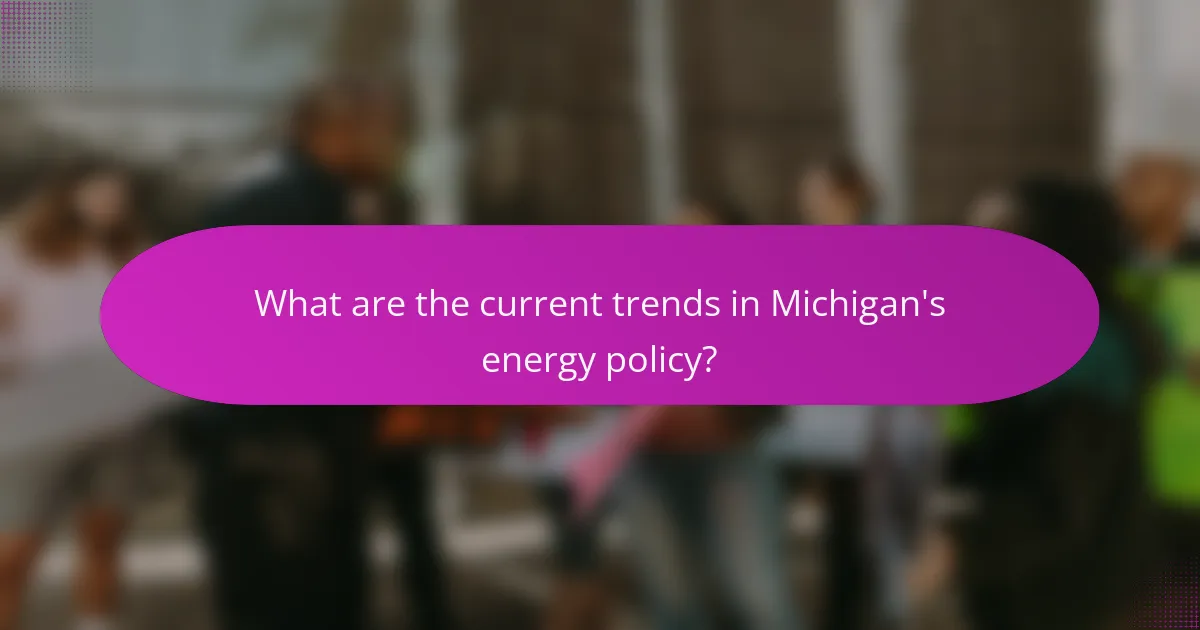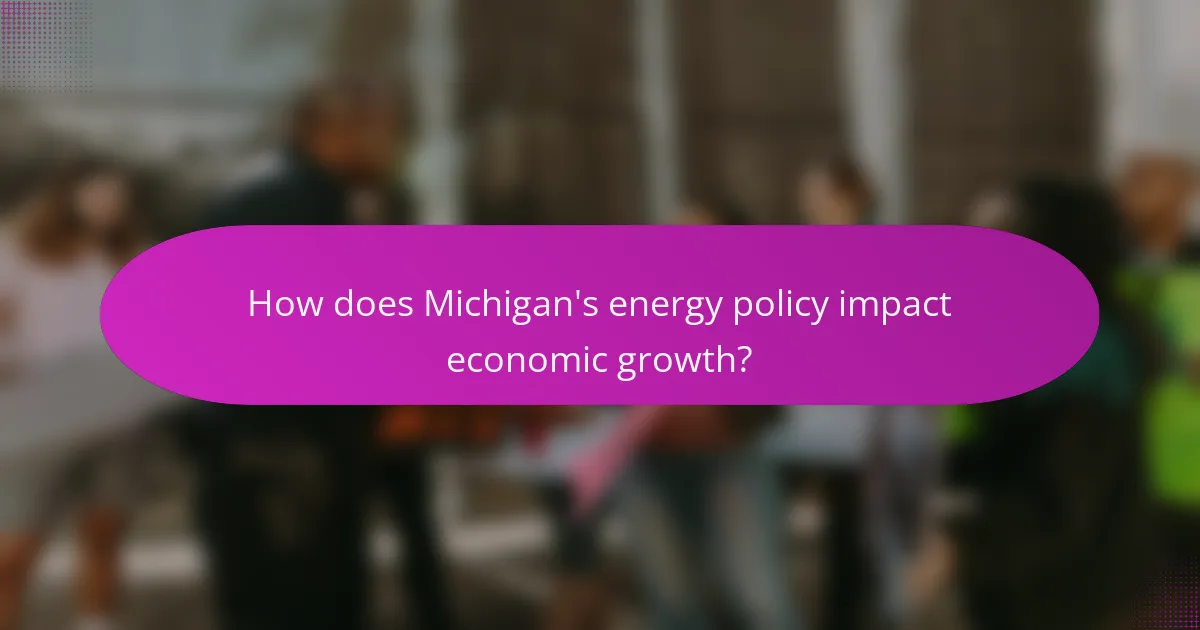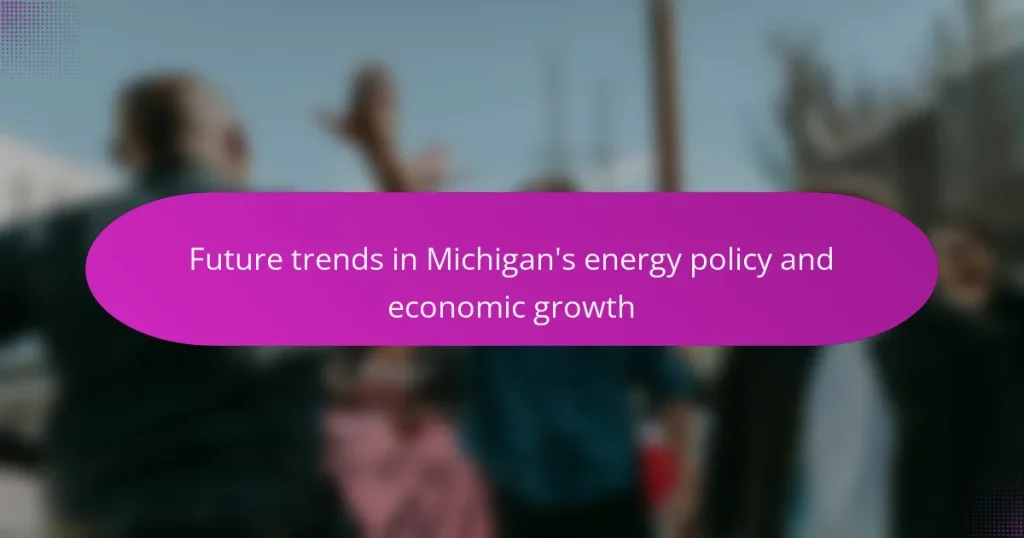
What are the current trends in Michigan’s energy policy?
Michigan’s energy policy is currently focused on increasing renewable energy sources and improving energy efficiency. The state aims to achieve a 50% reduction in greenhouse gas emissions by 2030. Michigan is also investing in electric vehicle infrastructure to support a transition to cleaner transportation. The state has set a goal of 100% carbon-free electricity by 2040. Additionally, there is a push for more community solar projects to increase access to renewable energy. The Michigan Public Service Commission is actively promoting energy waste reduction programs. These trends reflect a broader commitment to sustainability and economic growth in the energy sector.
How is renewable energy shaping Michigan’s energy landscape?
Renewable energy is significantly transforming Michigan’s energy landscape. The state aims to achieve 50% renewable energy by 2030. This shift is driven by policies promoting clean energy sources. Wind and solar power are the primary contributors to this growth. Michigan has seen a 25% increase in renewable energy capacity since 2015. The transition is also creating jobs in the green energy sector. In 2021, Michigan’s renewable energy sector employed over 100,000 workers. Additionally, investments in renewable infrastructure are boosting local economies. Overall, renewable energy is reshaping Michigan’s energy policy and economic growth trajectory.
What types of renewable energy sources are being prioritized?
Solar energy and wind energy are the primary renewable energy sources being prioritized. Michigan’s energy policy emphasizes these sources due to their potential for large-scale generation. Solar energy installations have increased significantly, with over 1,500 MW of capacity as of 2023. Wind energy also plays a crucial role, contributing approximately 25% of the state’s renewable generation. The state government aims for a 50% renewable energy target by 2030. This goal aligns with federal initiatives to reduce carbon emissions and promote clean energy. Investments in solar and wind infrastructure are expected to drive economic growth and job creation in Michigan.
How do these sources impact Michigan’s economy?
These sources significantly impact Michigan’s economy by driving job creation and investment. Renewable energy sources, such as wind and solar, contribute to a growing clean energy sector. This sector has created over 100,000 jobs in Michigan as of 2022. Investments in energy efficiency also save consumers money, fostering economic growth. Additionally, these sources reduce reliance on fossil fuels, stabilizing energy prices. The shift towards sustainable energy attracts businesses seeking environmentally friendly operations. Overall, Michigan’s transition to these energy sources enhances economic resilience and growth.
What role does legislation play in Michigan’s energy policy?
Legislation plays a crucial role in shaping Michigan’s energy policy. It establishes the framework for energy production, distribution, and consumption. Specific laws dictate renewable energy standards and efficiency targets. For instance, the 2008 Energy Optimization Act mandates energy savings programs for utilities. Additionally, the Clean and Renewable Energy Act encourages the development of renewable resources. These legislative measures aim to reduce greenhouse gas emissions and promote sustainable practices. The Michigan Public Service Commission oversees compliance with these laws. This regulatory body ensures that energy providers meet state mandates. Overall, legislation is fundamental in guiding Michigan towards a more sustainable energy future.
What recent laws or regulations have been enacted?
Recent laws enacted in Michigan’s energy policy include the Clean and Renewable Energy Act. This law mandates a transition to 50% renewable energy sources by 2030. Additionally, the Act includes provisions for energy efficiency improvements. It aims to reduce greenhouse gas emissions significantly. The law was passed in 2022 and reflects a commitment to sustainable energy practices. Furthermore, regulations have been introduced to support electric vehicle infrastructure expansion. These changes are part of Michigan’s broader strategy for economic growth and environmental sustainability.
How do these laws influence economic growth in the state?
These laws influence economic growth in the state by promoting renewable energy development. They encourage investment in clean energy technologies. This investment creates jobs in manufacturing, installation, and maintenance sectors. For instance, Michigan’s Renewable Energy Standard mandates that 15% of energy must come from renewable sources by 2021. This requirement has spurred growth in solar and wind industries. Additionally, the laws facilitate innovation and attract businesses focused on sustainability. The result is a more resilient economy that reduces reliance on fossil fuels. Overall, these policies contribute to long-term economic stability and growth in Michigan.
What are the challenges facing Michigan’s energy policy?
Michigan’s energy policy faces several challenges. Transitioning to renewable energy sources is a significant hurdle. The state aims to increase renewable energy usage to 50% by 2030. However, achieving this goal requires substantial investments in infrastructure. Additionally, there are regulatory complexities that slow down the implementation of new energy projects. The aging energy grid also poses reliability issues. Furthermore, balancing energy affordability with sustainability remains a critical concern. Lastly, public opposition to certain energy projects can hinder progress. These challenges must be addressed to ensure a successful energy transition in Michigan.
What economic factors hinder the implementation of energy policies?
High initial costs hinder the implementation of energy policies. Investments in renewable energy infrastructure require significant capital. Many governments lack the necessary funding for these projects. Economic uncertainty can lead to reduced public and private investments. Additionally, fluctuating energy prices affect the feasibility of new policies. For instance, when fossil fuel prices are low, renewable energy becomes less competitive. Regulatory complexities can also increase costs and deter investment. Finally, the potential for job losses in traditional energy sectors creates political resistance to change.
How do public opinions affect energy policy decisions?
Public opinions significantly influence energy policy decisions. Policymakers often consider public sentiment when shaping energy regulations. Public support for renewable energy can lead to increased funding for such initiatives. Conversely, opposition to certain energy sources may result in stricter regulations or bans. Surveys indicate that a majority of Michiganders favor clean energy, impacting legislative priorities. Additionally, public advocacy groups play a crucial role in mobilizing community support. Their campaigns can sway public opinion and, subsequently, political action. Overall, the alignment of public opinion with energy policy can drive economic growth and sustainable practices in Michigan.

How does Michigan’s energy policy impact economic growth?
Michigan’s energy policy significantly impacts economic growth by promoting clean energy initiatives. These initiatives attract investment in renewable energy sectors. For instance, Michigan aims to achieve a 50% renewable energy portfolio by 2030. This commitment fosters job creation in manufacturing and installation of renewable technologies. The state has seen over 5,000 jobs created in the solar sector alone since 2019. Additionally, energy efficiency programs reduce operational costs for businesses. Lower energy costs enhance competitiveness, driving economic expansion. Research from the Michigan Energy Innovation Business Council highlights that clean energy investments can generate $15 billion in economic activity by 2030. Thus, Michigan’s energy policy is a catalyst for sustainable economic growth.
What sectors are most affected by energy policy changes?
The sectors most affected by energy policy changes include the energy sector, transportation, manufacturing, and residential sectors. The energy sector experiences direct impacts due to regulations and incentives aimed at renewable energy sources. Transportation is influenced by policies promoting electric vehicles and alternative fuels. Manufacturing faces changes in energy costs and efficiency standards that can affect operational expenses. The residential sector is impacted through energy efficiency programs and incentives for renewable energy installations. These sectors collectively shape the economic landscape in response to evolving energy policies.
How does energy policy influence job creation in Michigan?
Energy policy significantly influences job creation in Michigan by promoting renewable energy initiatives. These initiatives lead to investments in solar, wind, and other clean energy sectors. For instance, Michigan’s commitment to increasing renewable energy standards has spurred job growth in manufacturing and installation. According to a report by the Michigan Energy Innovation Business Council, the clean energy sector employed over 100,000 people in 2020. Furthermore, energy efficiency programs create additional jobs in retrofitting and building upgrades. The transition to a cleaner energy economy fosters innovation and attracts new businesses, further enhancing job opportunities. Overall, effective energy policies drive economic growth and job creation in Michigan.
What is the relationship between energy costs and business growth?
Energy costs significantly impact business growth. Higher energy costs can reduce profit margins for companies. This, in turn, limits their ability to invest in expansion or innovation. For example, a study by the U.S. Energy Information Administration found that businesses spend approximately 1.5% of their revenue on energy. When energy prices rise, this percentage increases, straining budgets. Conversely, lower energy costs can enhance competitiveness. Companies can allocate savings toward hiring or new projects. Therefore, the relationship between energy costs and business growth is direct and critical.
How are investments in energy technology driving economic development?
Investments in energy technology drive economic development by creating jobs and fostering innovation. These investments lead to the establishment of new companies and industries focused on renewable energy sources. For instance, in Michigan, the clean energy sector has seen significant growth, resulting in over 100,000 jobs created since 2008. Additionally, energy technology investments enhance energy efficiency, reducing costs for businesses and consumers. This increased efficiency can lead to higher disposable income, which stimulates local economies. Furthermore, advancements in energy technology attract additional investments, creating a cycle of growth and development. Overall, the integration of energy technology into Michigan’s economy supports sustainable growth and positions the state as a leader in the clean energy transition.
What types of energy technologies are attracting investment?
Renewable energy technologies are attracting significant investment. Solar power is leading with a rapid decrease in installation costs. Wind energy is also gaining traction, supported by advancements in turbine efficiency. Energy storage technologies, particularly lithium-ion batteries, are essential for balancing supply and demand. Electric vehicle infrastructure is receiving funding to support the transition to cleaner transportation. Additionally, hydrogen fuel cells are emerging as a promising alternative energy source. According to the International Energy Agency, global investment in renewable energy reached $300 billion in 2020. This trend reflects a growing commitment to sustainable energy solutions.
How do these technologies contribute to economic sustainability?
These technologies contribute to economic sustainability by enhancing energy efficiency and reducing operational costs. For instance, renewable energy technologies lower dependence on fossil fuels. This transition can lead to job creation in the renewable sector. According to a report by the U.S. Department of Energy, solar and wind industries employ more workers than fossil fuel sectors. Additionally, smart grid technologies optimize energy distribution, minimizing waste. A study by the Rocky Mountain Institute found that smart grid implementation can save consumers up to $2 billion annually. Overall, these technologies foster a resilient economy by promoting sustainable practices and reducing long-term costs.

What future trends can we expect in Michigan’s energy policy and economy?
Michigan’s energy policy and economy are expected to trend towards increased renewable energy adoption. The state aims to achieve 50% renewable energy by 2030. This shift is driven by legislative efforts and public support for clean energy. Additionally, energy efficiency programs are likely to expand. These initiatives will help reduce overall energy consumption. The transition to electric vehicles will also play a significant role. Michigan has set ambitious goals for EV infrastructure development. Furthermore, job creation in the clean energy sector is anticipated to rise. This aligns with national trends in green job growth. Overall, Michigan’s energy future is leaning towards sustainability and innovation.
How might emerging technologies reshape energy consumption?
Emerging technologies will significantly reshape energy consumption by enhancing efficiency and integrating renewable sources. Smart grids enable real-time monitoring and management of energy use, reducing waste. Energy-efficient appliances lower consumption levels in homes and industries. Electric vehicles promote a shift from fossil fuels to cleaner energy sources. Battery storage technologies allow for better utilization of renewable energy, balancing supply and demand. Additionally, advancements in artificial intelligence optimize energy distribution and consumption patterns. According to the U.S. Department of Energy, smart grid technologies can reduce energy consumption by up to 30%. These innovations collectively contribute to a more sustainable and efficient energy landscape.
What innovations are on the horizon for Michigan’s energy sector?
Michigan’s energy sector is set to innovate through advancements in renewable energy technologies. These innovations include the expansion of solar and wind energy capacity. Michigan aims to increase its renewable energy portfolio to 50% by 2030. Battery storage technology is also expected to improve, enhancing grid reliability. Electric vehicle infrastructure will grow, supporting the transition to cleaner transportation. Smart grid technologies will be implemented to optimize energy distribution. Energy efficiency programs will be expanded, reducing overall consumption. Research partnerships with universities will drive innovation in clean energy solutions.
How will these innovations affect economic opportunities?
Innovations in Michigan’s energy policy will enhance economic opportunities. These advancements will likely lead to job creation in renewable energy sectors. For example, the solar and wind industries are projected to grow significantly. According to the U.S. Department of Energy, renewable energy jobs could increase by over 300,000 by 2030. Furthermore, innovations may attract investments in green technologies. This influx of capital can stimulate local economies and support infrastructure development. Enhanced energy efficiency can also lower operational costs for businesses. Overall, these innovations will create a more sustainable economic landscape in Michigan.
What strategies can Michigan adopt for sustainable growth?
Michigan can adopt strategies such as investing in renewable energy sources and enhancing energy efficiency. Transitioning to wind and solar power can reduce reliance on fossil fuels. The state can also implement policies that encourage green technology innovation. Supporting local agriculture through sustainable practices can boost the economy and reduce carbon footprints. Promoting public transportation can decrease traffic congestion and emissions. Additionally, Michigan can enhance workforce development in clean energy sectors. According to the Michigan Renewable Energy Report, the state aims for 50% renewable energy by 2030. This commitment can drive job creation and economic growth while ensuring environmental sustainability.
How can policy frameworks support a transition to clean energy?
Policy frameworks can support a transition to clean energy by establishing clear regulations and incentives. These frameworks can create a stable environment for investment in renewable technologies. For instance, policies like tax credits for solar and wind energy can stimulate growth in these sectors. Additionally, regulations that mandate renewable energy targets can drive utilities to adopt cleaner practices. Research shows that states with strong policy frameworks have seen significant increases in clean energy capacity. In Michigan, the Clean and Renewable Energy Act aims to increase the share of renewable energy in the state’s energy mix. Such policies can lead to job creation in the clean energy sector, contributing to economic growth.
What best practices can be implemented to enhance economic resilience?
Diversifying the economy is a best practice to enhance economic resilience. This involves promoting various sectors, reducing dependency on a single industry. For instance, Michigan can support renewable energy, manufacturing, and technology sectors. Investing in education and workforce development strengthens human capital. A skilled workforce can adapt to changing job markets. Implementing robust infrastructure improves connectivity and supports business growth. Research shows that states with diverse economies recover faster from downturns. According to the U.S. Bureau of Economic Analysis, economic diversification can lead to sustained growth. Establishing emergency funds helps manage financial shocks effectively. This practice provides resources during economic downturns. Overall, these practices contribute to a more resilient economy.
What practical steps can stakeholders take to align energy policy with economic growth?
Stakeholders can align energy policy with economic growth by implementing integrated planning. This involves collaboration among government, industry, and communities. Stakeholders should assess energy needs and economic goals simultaneously. They can promote renewable energy investments to create jobs. Incentives for clean energy technologies can stimulate economic development. Policymakers must establish clear regulations that support sustainable practices. Regular evaluations of energy policies can ensure they meet economic objectives. Engaging local communities in decision-making enhances acceptance and participation. These steps are supported by research showing that integrated energy planning boosts economic resilience.
The main entity of this article is Michigan’s energy policy and its impact on economic growth. The article outlines current trends in Michigan’s energy policy, focusing on the transition to renewable energy, legislative support, and the economic implications of these changes. Key topics include the prioritization of solar and wind energy, job creation in the clean energy sector, and the challenges faced in implementing energy policies. Additionally, it discusses future trends, innovations in energy technology, and strategies for sustainable growth that align energy initiatives with economic development.

